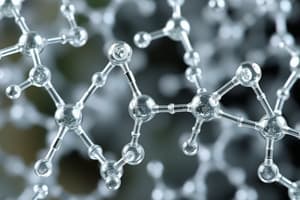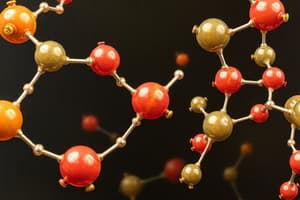Podcast
Questions and Answers
Which of the following is NOT a type of biomolecule?
Which of the following is NOT a type of biomolecule?
- Carbohydrates
- Lipids
- Proteins
- Metalloids (correct)
Monomers can connect with each other to form polymers through a process known as hydrolysis.
Monomers can connect with each other to form polymers through a process known as hydrolysis.
False (B)
What are the monomers that make up lipids?
What are the monomers that make up lipids?
Fatty acids and glycerol
Proteins are composed of ________ which come in 20 different types.
Proteins are composed of ________ which come in 20 different types.
Match each biomolecule with its primary function:
Match each biomolecule with its primary function:
What type of biomolecule are starch and glycogen classified as?
What type of biomolecule are starch and glycogen classified as?
Nucleotides are the monomers of proteins.
Nucleotides are the monomers of proteins.
Name one function of lipids in living organisms.
Name one function of lipids in living organisms.
Flashcards
Biomolecules
Biomolecules
Organic molecules essential for life, produced by living organisms.
Monomers
Monomers
Basic building blocks of polymers; small, simple molecules.
Polymers
Polymers
Large molecules composed of repeating monomer subunits.
Carbohydrates
Carbohydrates
Signup and view all the flashcards
Lipids
Lipids
Signup and view all the flashcards
Proteins
Proteins
Signup and view all the flashcards
Nucleic Acids
Nucleic Acids
Signup and view all the flashcards
Dehydration Synthesis
Dehydration Synthesis
Signup and view all the flashcards
Study Notes
Biomolecules: Overview
- Biomolecules are organic molecules essential for life, produced by living organisms.
- Four major classes: carbohydrates, lipids, proteins, and nucleic acids.
- These biomolecules vary in structure and perform diverse functions.
Monomers
- Monomers are the basic building blocks of polymers.
- They are small, simple molecules.
- Examples include monosaccharides (carbohydrates), amino acids (proteins), nucleotides (nucleic acids), and fatty acids (lipids).
- Monomers link together via dehydration synthesis to form polymers.
Polymers
- Polymers are large, complex molecules composed of repeating monomer subunits.
- They are formed by joining monomers together through covalent bonds.
- Examples include polysaccharides (carbohydrates), proteins (amino acids), and nucleic acids (nucleotides).
- Polymers often have specific shapes and structures, determined by the arrangement of monomers, which affect their function.
Carbohydrates
- Function: Provide energy and structural support.
- Monomers: Monosaccharides (e.g., glucose, fructose, galactose).
- Polymers: Disaccharides (e.g., sucrose, lactose) and polysaccharides (e.g., starch, glycogen, cellulose).
- Carbohydrates often serve as a key energy source for cellular processes and are involved in other crucial biological functions.
Lipids
- Function: Store energy, provide insulation, form cell membranes.
- Examples: Fats, oils, waxes, steroids (e.g., cholesterol).
- Monomers: Fatty acids and glycerol (generally).
- Structure: Often composed of long hydrocarbon chains.
- Fats and oils are important energy storage molecules, while phospholipids are a major component of cell membranes. Steroids, like cholesterol, have vastly different functions.
Proteins
- Function: Diverse, including catalyzing reactions (enzymes), transporting molecules, providing structural support, and mediating responses to stimuli.
- Monomers: Amino acids (20 different types).
- Structure: Complex three-dimensional shapes determined by the sequence and interactions of amino acids. A protein's function depends upon its shape.
- Proteins are essential for many cellular functions, acting as enzymes, transport proteins, structural components, and more.
Nucleic Acids
- Function: Store and transmit genetic information.
- Types: DNA and RNA.
- Monomers: Nucleotides (e.g., adenine, guanine, cytosine, thymine, uracil).
- Structure: Long chains of nucleotides with a sugar-phosphate backbone.
- DNA stores genetic information, while RNA plays crucial roles in protein synthesis and other cellular processes.
Biomolecules Structure and Function Relationship
- The specific structure of a biomolecule directly relates to its function.
- For example, the precise sequence of amino acids in a protein determines its shape and therefore its function.
- The folded shape of a protein dictates its ability to bind to other molecules.
- The shape and arrangement of a molecule plays a critical role in its function as a catalyst, structural element, or transporter, etc.
- The molecular shapes of biomolecules are essential for their interactions within a living cell.
Studying That Suits You
Use AI to generate personalized quizzes and flashcards to suit your learning preferences.




